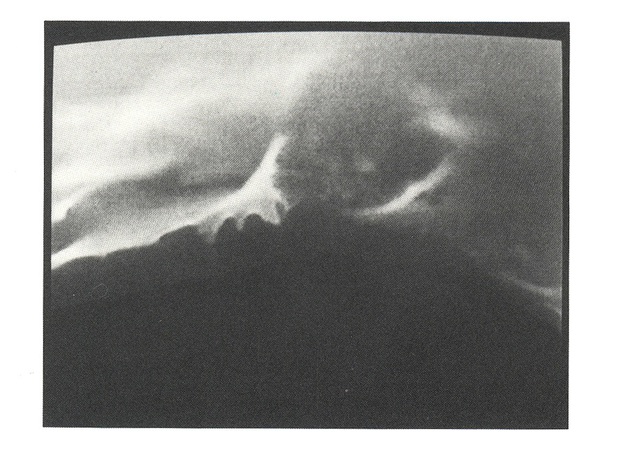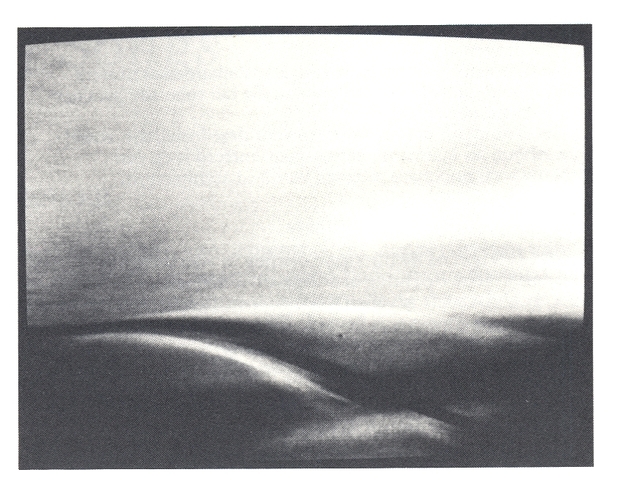Three monitors, on tall, slender pedestals, are each showing a landscape. The monitor on the left shows an impressive mountain with a snowy peak. Wisps of mist drift round the mountain. The image of the landscape is composed of many different shades of grey mixed with blue.
The monitor in the middle emits an orange glow, in the form of a hilly landscape, and suggests a desert.
The monitor on the right shows a road through a rolling country-side. Contrary to the two other tableaux, this sky is of a light colour, and not hidden behind the landscape. The colours yellow and blue were used for this tape.
Only very slight changes can be perceived in the landscapes: differences of light and dark give the impression that the forms are changing place, and produce other shades of colour. However, the image stays the same.
The beauty of these still landscapes is almost unreal and suggests that these are dream-visions. The artist has appropriately entitled this: the imagined landscape. This feature of Travel in Light is very close to its intention. The ideal location for this installation would be an airport. Thus NAN HOOVER's proposal to place Travel in Light in a quiet nook of the departure hall of Schiphol Airport Amsterdam. Travellers, made nervous by the hectic atmosphere of the airport, are taken by NAN HOOVER to landscapes that only exist in the imagination and the subconscious.
The installation evokes memories of landscapes that one has seen before, which in the meantime have already become dream-visions. In this way the installation can function as a point of rest in the hurried atmosphere of the departure hall.
It is remarkable that for the creation of these ideal landscapes NAN HOOVER did not use intricate forms of image manipulation, but only worked with paper structures and light.
Dialogue
Travel in Light is also intended for a public which is not normally interested in video art. At the moment NAN HOOVER is employed in making video art meant for public buildings. She wants her installations to start a dialogue with the building and its function. This kind of video art, intended for a wider audience than most video art, is quite suitable for art sponsoring, and in the future NAN HOOVER hopes to collaborate with business companies.
At the moment she is working on another installation which is intended for the entrance hall of a college for architecture.
Five monitors placed on tall pedestals form a semi-circle with its convex side towards the entrance. The monitor screens are on the concave side. The tape shown in the installation shows how Japanese architecture deals with form, space and light. The artist focuses on the efficiency of Japanese architecture. The Japanese are always trying to reveal the essence of a certain space.
This philosophic inside of the installation contrasts strongly with its massive exterior, which symbolizes the robust nature of architecture.
Clearly the design for this installation in form and content is intended for a building which houses a college for architecture.
Space
Travel in Light, and the installation which she is working on now, seem to poim to a new direction in NAN HOOVER's work. Both pieces refer to the locations where they are placed. This aspect was absent from her earlier video work.
Compared to her earlier work, however, the changes are not really marked. In her earlier work as well, she explored 'space', besides light and motion. In her present work, she looks at 'space' from different angles, and also takes into account the function of a certain space. In earlier tapes and performances she highlighted the space in relation to light and dark, and motion within a certain space. An evolved version of her experiences seems to manifest itself in Travel in Light. In a very early tape, like Enclosures (1975) NAN HOOVER is already showing how the incidence of light can change the forms of bodies and paper structures. In Landscapes (1977) a landscape is suggested by means of close-ups of a face. Here again forms are changed under the influence of light. Three-dimensional structures (bodies, paper-structures) are used in these tapes to create new effects by means of light and shadow. A space is created which can only exist in the imagination.
In a tape like Projections (1980) NAN HOOVER starts from an existing space, a room, which in combination with sunlight forms the medium for moving dream-visions. The tape was made in Berlin in 1980. NAN was given a grant from the DAAD (Deutsche Akademische Austausch Dienst), enabling her to work in Berlin for one year. Referring to this period in a 1981 interview, she said: The studio offered by the DAAD has had great influence on me. It was a large space, cut into two parts, in the Bundesallee. At the other side of this busy street is a huge cori/plex of buildings. When I came here in June 1980 the sunlight immediately made a profound impression on me.1) Projections are the shadows of passing traffic and pedestrians on the walls of her studio; in the tape they have a life of their own.
The new approach to space in Travel in Light and the next project is the fact that she no longer uses a certain space only to express something. In addition she concentrates not only on imaginary spaces, but also on existing spaces with their specific characteristics, She made a link, as it were, between the spaces in our minds, the 'imagined landscapes' in Travel in Light, and the actual space we find ourselves in, in the case of Travel in Light the departure hall. Similar aspects can be found in the installations which she is working on now. Here NAN HOOVER links an existing space with ideas about the use of space, form and light in Japan.
A more extrovert approach now supplements the introspective way in which NAN HOOVER dealt with light, form and space in her earlier work. This adds an extra dimension to her work, and provides a well-defined destination for the poetic, introvert video images.
1) Willem van Beek Nan Hoover; de relatie tussen beeld en imagination in: Kunstbeeld 8 irg. 5 Amsterdam
If you'd like to quote something: Rajandream, Marie Adèle. "Travel in Light." Mediamatic Magazine vol. 1 # 3 (1987).


